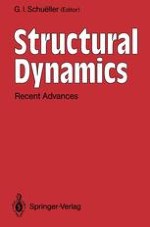1991 | OriginalPaper | Buchkapitel
Seismic Waves in Layered Soil: The Generalized Ray Theory
verfasst von : P. Borejko, F. Ziegler
Erschienen in: Structural Dynamics
Verlag: Springer Berlin Heidelberg
Enthalten in: Professional Book Archive
Aktivieren Sie unsere intelligente Suche, um passende Fachinhalte oder Patente zu finden.
Wählen Sie Textabschnitte aus um mit Künstlicher Intelligenz passenden Patente zu finden. powered by
Markieren Sie Textabschnitte, um KI-gestützt weitere passende Inhalte zu finden. powered by
Methods of structural dynamics find practical applications in the earthquake resistant design of major structures, such as sky-scrapers, nuclear power stations, hospitals and large dams and bridges located in seismically active regions. In the past, earthquake resistant design criteria for such structures usually employed the so-called design response spectrum (see Newmark and Rosenblueth [2.3–1] and Clough and Penzien [2.3–2]). This spectrum is based on estimated values of certain numerical indices of the expected strong ground motion at the structure site. The indices, constructed from empirical relations supplied by the analysis of available ground motion records and other historical data (see, e.g., Hays [2.3–3]), include peak values of the ground displacement, velocity and acceleration as well as their dominant periods. Since the significant amount of reliable data for the most important cases of severe events and small epicentral distances is still not available, the reliability of these empirical relations is doubtful. Consequently, in modern civil engineering practice, the design response spectrum is applicable at preliminary design stages; the ultimate proportioning of a structure requires an explicit description of the expected ground motion at the site (see Clough and Penzien [2.3–2]). (Actually, the design response spectrum is not applicable to structures with nonlinear responses or involving various types of structural interactions. For such structures, an actual time history record of ground motion is, as it was pointed out by Clough and Penzien [2.3–2], indispensable). More reliable criteria for structural design employ more detailed descriptions of the expected ground motion (see Scanlan [2.3–4]). The best information is provided by complete time histories of ground displacement, velocity and acceleration likely to occur at the site.
